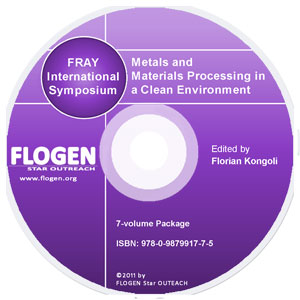
CD shopping page |
2011-Sustainable Industrial Processing Summit
|
| Editors: | Florian K |
| Publisher: | Flogen Star OUTREACH |
| Publication Year: | 2012 |
| Pages: | 646 pages |
| ISBN: | 978-0-9879917-6-8 |
| ISSN: | 2291-1227 (Metals and Materials Processing in a Clean Environment Series) |
Study Of The Processes Taking Place During Synthesis Of Hafnium Oxide And Its Thermal Treatment
Yakov S. Bataev1; Ilya Polovov1; Yuri D. Afonin1; Oleg I. Rebrin1; Vladimir Volkovich1; Olga V. Denisova1; Andrew V. Chukin1; Aelita K. Shtoltz1; Trevor Griffiths2;1URAL FEDERAL UNIVERSITY, Ekaterinburg, Russia; 2REDSTON TREVOR CONSULTING LTD, Leeds, United Kingdom;
Type of Paper: Regular
Id Paper: 176
Topic: 9
Abstract:
Currently there is a sharp increase in hafnium oxide demand due to its growing consumption in several branches of modern technology. HfO2 has important technological applications as catalyst support, gate dielectric in metaloxide semiconductor devices, oxygen detectors, high temperature fuel cell electrolytes and optical fibers. One of widely used methods of hafnium oxide synthesis comprises precipitation of hydrated hafnium hydroxide from aqueous solutions and subsequent thermal treatment. However, the mechanism of the process was never studied in detail, and the data concerning the phase composition and the transformation temperatures are contradictive. In the present work the results of complex studies of the processes taking place during hafnium oxide preparation are described. The experiments included thermal and phase analysis, vibration spectroscopy and determining specific surface area. Thermogravimetric (with on-line mass-spectroscopy analysis of the gas phase) and simultaneous differential thermal analysis (SDTA) of hydrated hafnium hydroxide samples was carried out with the heating rate of 10 °С/min and air flowing through the furnace. The total sample weight decrease was 85 %, with 99 % of water removed up to 250 oC. There were two endothermic effects (maxima at 131 and 235 °С) and one intense exothermic peak (at 555 °С). The endothermic effects were accompanied by water and carbon dioxide evolution. The heat effects of the endothermic processes (145.7 and 21.9 J/g) and the exothermic transformation (95.7 J/g) were determined using differential scanning calorimetry. The nature of water and carbonate-species present in the samples was determined using high temperature infra-red spectroscopy measurements. It was shown, that the non-structural water evaporates at the first stage resulting in the formation of HfO(OH)2 (or Hf4O4(OH)8) after 200 °С. Further heating leads to HfO2. Changes of the phase composition upon heating were studied using high temperature X-ray powder diffraction analysis in the temperature range from 20°С to 950 °С with heating rate of 10 °С/min. At 540-560 °С the formation of a metastable tetragonal hafnium oxide phase was noticed. The temperature of its formation agrees well with results of SDTA and DSC measurements. Increasing temperature to 730-750 °С led to the appearance of monoclinic HfO2. Further raising the temperature resulted in gradual increasing the amount of monoclinic phase and decreasing the fraction of the tetragonal phase. Cooling heated samples of monoclinic HfO2 did not produce any tetragonal phase, the phase transformation is irreversible. Thus, the following stages of hafnium oxide formation were determined: two step dehydration of hydrated Hf(OH)4 (removal of structural water and decomposition of HfO(OH)2), crystallization of metastable tetragonal HfO2 and its irreversible transformation to the monoclinic phase.